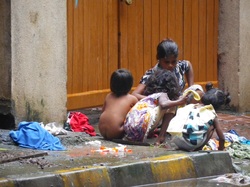 Pavement dwellers, Mumbai 2013.
Pavement dwellers, Mumbai 2013. Before I began my summer vacation, I marked diploma exams. Of the 300 or so papers I marked, only one of them mentioned India. And I realized we don’t really teach about India even though it’s a vital nation to look at, especially in terms of ideology, freedom and equality.
You may have heard of India –the world’s largest democracy-as poster child for the liberalization of trade. It has had impressive growth rates over the last decades as it moved away from a socialist economy. I thought of it as a bit of a miracle myself until this summer when I travelled there for a month. I’m not an expert on the country, but it was a mindboggling trip that made me stop and think.
Culturally and linguistically more diverse than the entire continent of Africa, India is faced with enormous challenges. Although the food is fabulous and although India ranks second in the world for agricultural output, 55% of India’s children suffer from malnutrition. It is home to one third of the world’s poor. What does “poor” mean? The government defines extreme poverty (experienced by 138 million of its citizens) as living on 44 Canadian cents a day. We know that no one in Canada could survive on that little money. Although things are definitely cheaper in India, even the cheapest meal costs 31 cents. There is a lot of debate about what poverty really means. Economists say they have to keep that definition low, because if the definition was changed, the government would have to provide subsidies to 2/3 of the entire population.
There is a great deal of disparity in India. Slums beside elegant apartment complexes; luxury SUVs drive alongside rickshaws; pavement dwellers live on sidewalks just meters away from upscale hotels. In his novel Shantaram Gregory David Roberts talks about the great freedom of India, suggesting that it’s great that the poor are free to live right beside the rich. But to my mind, if the rich see the poor living right beside them, wouldn’t they want to do something about it? That doesn’t seem to be the case as income disparity has doubled over the past 20 years.
Everywhere I went I saw men. Men lined up at security checkpoints. Men in museums. Men working in stores and hotels and farms. But women? Not so many. Although female infanticide and gender-selective abortion are illegal, there are presently 37 million more men than women in India. Most of these girls are aborted before birth; others are mistreated and malnourished to the point that in the 0-6 age group, there are 7 million fewer girls than boys. Look at the website 50 million missing, founded by activist Rita Banerji, who graciously donated some of her photos for use in this course.
India is a beautiful country filled with spectacular natural beauty and fabulous buildings. Its people are warm and friendly. It’s an amazing place to visit. It’s even more interesting look at from the perspective of liberalism. In the case of freedom and equality, India shows they do not always go hand in hand.
You may have heard of India –the world’s largest democracy-as poster child for the liberalization of trade. It has had impressive growth rates over the last decades as it moved away from a socialist economy. I thought of it as a bit of a miracle myself until this summer when I travelled there for a month. I’m not an expert on the country, but it was a mindboggling trip that made me stop and think.
Culturally and linguistically more diverse than the entire continent of Africa, India is faced with enormous challenges. Although the food is fabulous and although India ranks second in the world for agricultural output, 55% of India’s children suffer from malnutrition. It is home to one third of the world’s poor. What does “poor” mean? The government defines extreme poverty (experienced by 138 million of its citizens) as living on 44 Canadian cents a day. We know that no one in Canada could survive on that little money. Although things are definitely cheaper in India, even the cheapest meal costs 31 cents. There is a lot of debate about what poverty really means. Economists say they have to keep that definition low, because if the definition was changed, the government would have to provide subsidies to 2/3 of the entire population.
There is a great deal of disparity in India. Slums beside elegant apartment complexes; luxury SUVs drive alongside rickshaws; pavement dwellers live on sidewalks just meters away from upscale hotels. In his novel Shantaram Gregory David Roberts talks about the great freedom of India, suggesting that it’s great that the poor are free to live right beside the rich. But to my mind, if the rich see the poor living right beside them, wouldn’t they want to do something about it? That doesn’t seem to be the case as income disparity has doubled over the past 20 years.
Everywhere I went I saw men. Men lined up at security checkpoints. Men in museums. Men working in stores and hotels and farms. But women? Not so many. Although female infanticide and gender-selective abortion are illegal, there are presently 37 million more men than women in India. Most of these girls are aborted before birth; others are mistreated and malnourished to the point that in the 0-6 age group, there are 7 million fewer girls than boys. Look at the website 50 million missing, founded by activist Rita Banerji, who graciously donated some of her photos for use in this course.
India is a beautiful country filled with spectacular natural beauty and fabulous buildings. Its people are warm and friendly. It’s an amazing place to visit. It’s even more interesting look at from the perspective of liberalism. In the case of freedom and equality, India shows they do not always go hand in hand.

 RSS Feed
RSS Feed